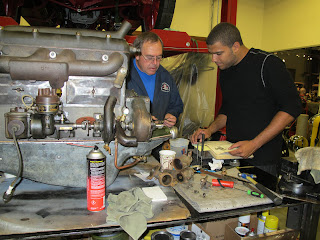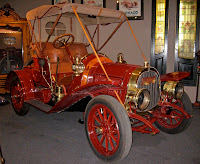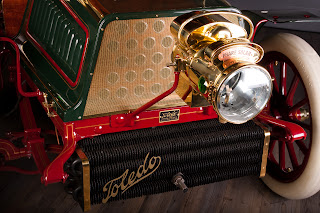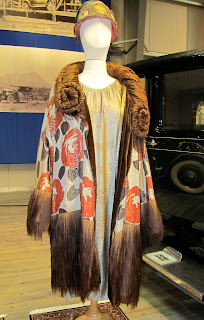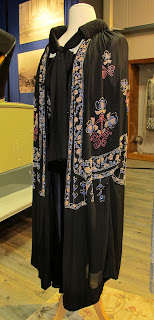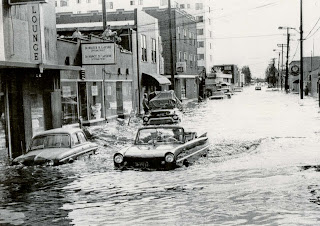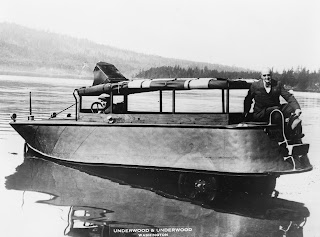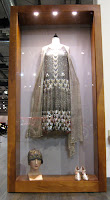Guest post by Kevin Triplett
Originally posted on openwheelracers3.com on 27 September 2012
© Kevin Triplett 2012
Motion pictures and auto racing grew up together - the earliest Hollywood movies about auto racing were short, 9-minute silent films. One of the earliest, 1913’s The Speed Kings, starred three real-life race drivers in leading roles- Teddy Tetzlaff, Earl Cooper and Barney Oldfield.
This film should not be confused with similarly named films of the era; the documentary of the 1916 Corona Road Race, entitled The Speed King, in which Cooper and Oldfield also appeared, or the 1915 comedy short, Speed Kings, that starred Oliver Hardy (prior to teaming with Stan Laurel.) The plot of The Speed Kings is a variation of what has become a Hollywood standby; a daughter, played by Mabel Normand, is in love with Tetzlaff’s character, but her father played by Ford Sterling, considers Cooper’s character as the better match for his daughter. Oldfield plays another racer, while Roscoe “Fatty” Arbuckle, in the early stages of his career is a featured performer playing a track official.
At the time of the release of The Speed Kings in 1913, only Tetzlaff had raced in the Indianapolis ‘500’ but all three drivers had national reputations. Tetzlaff’s reputation was of being hard on his equipment, (his nickname was “Terrible Teddy”) although he had scored a second place finish in the 1912 ‘500.’ Tetzlaff and Barney Oldfield were great friends, and after he had retired from driving in 1914 to work in Hollywood as a technical advisor, Teddy helped Oldfield to appear in nine more short films. Tetzlaff’s son, Ted, later forged his own career in Hollywood as a cinematographer and director, with the highlight being his acclaimed work as the director of cinematography on Hitchcock's 1946 classic Notorious. Earl Cooper won the AAA national championship in 1913 and 1915 and made seven starts at the Speedway between 1914 and 1926. Earl won the pole position for the ‘500’ in 1926, and recorded two top five ‘500’ finishes, fourth in 1915 and second in 1924 after he blew a tire while leading at lap 176.
![]() Long forgotten, McFarlan automobiles were a very expensive custom-built luxury car manufactured in Connersville, Indiana from 1909 through 1928. Patriarch John McFarlan started as a carriage builder in 1856, and developed a first of its kind industrial park setting surrounded by his suppliers, one of which included the Ansted Spring & Axle Company, which evolved into an auto parts manufacturing giant. Company owner William Ansted Junior entered a series of Ansted Rotary Engineering Specials at the Indianapolis Motor Speedway through the 1950s and was a co-owner of AJ Foyt’s 1964 Indy 500 winning car. The nearby Teetor Company built engines for McFarlan, and the Teetor Company evolved into the Perfect Circle Piston Ring Company, sponsor of the 1926 ‘500’ winner, and sponsor of the nationwide Mutual Broadcasting coverage of the Indy 500 from 1946 to 1951. McFarlan had its own limited racing pedigree, as their race cars participated in the September 1910 races at the Speedway, with a third and fifth finishes in the 200-mile feature, and third place finisher Winfield Barndollar completed the distance without a pit stop. McFarlan was one of 24 automobile makes that competed in the inaugural Indianapolis ‘500.’ Driver Melvon Marquette, who had participated in the June 1910 air show at the Speedway in his self-built airplane, and riding mechanic Al Adams, started 20th and finished 25th with 142 laps completed.
Long forgotten, McFarlan automobiles were a very expensive custom-built luxury car manufactured in Connersville, Indiana from 1909 through 1928. Patriarch John McFarlan started as a carriage builder in 1856, and developed a first of its kind industrial park setting surrounded by his suppliers, one of which included the Ansted Spring & Axle Company, which evolved into an auto parts manufacturing giant. Company owner William Ansted Junior entered a series of Ansted Rotary Engineering Specials at the Indianapolis Motor Speedway through the 1950s and was a co-owner of AJ Foyt’s 1964 Indy 500 winning car. The nearby Teetor Company built engines for McFarlan, and the Teetor Company evolved into the Perfect Circle Piston Ring Company, sponsor of the 1926 ‘500’ winner, and sponsor of the nationwide Mutual Broadcasting coverage of the Indy 500 from 1946 to 1951. McFarlan had its own limited racing pedigree, as their race cars participated in the September 1910 races at the Speedway, with a third and fifth finishes in the 200-mile feature, and third place finisher Winfield Barndollar completed the distance without a pit stop. McFarlan was one of 24 automobile makes that competed in the inaugural Indianapolis ‘500.’ Driver Melvon Marquette, who had participated in the June 1910 air show at the Speedway in his self-built airplane, and riding mechanic Al Adams, started 20th and finished 25th with 142 laps completed.
Marquette and the McFarlan racer returned to the Speedway with riding mechanic Lay Fowler in 1912; the pair finished 19th after they crashed in turn four and sheared off both right side wheels.
![]() His widow sold the new McFarlan to ‘Fatty’ Arbuckle following Reid’s death; the massive Reid/Arbuckle car is currently a part of the fantastic Nethercutt Collection in Sylmar California (at right).
His widow sold the new McFarlan to ‘Fatty’ Arbuckle following Reid’s death; the massive Reid/Arbuckle car is currently a part of the fantastic Nethercutt Collection in Sylmar California (at right).
Originally posted on openwheelracers3.com on 27 September 2012
© Kevin Triplett 2012
Motion pictures and auto racing grew up together - the earliest Hollywood movies about auto racing were short, 9-minute silent films. One of the earliest, 1913’s The Speed Kings, starred three real-life race drivers in leading roles- Teddy Tetzlaff, Earl Cooper and Barney Oldfield.
This film should not be confused with similarly named films of the era; the documentary of the 1916 Corona Road Race, entitled The Speed King, in which Cooper and Oldfield also appeared, or the 1915 comedy short, Speed Kings, that starred Oliver Hardy (prior to teaming with Stan Laurel.) The plot of The Speed Kings is a variation of what has become a Hollywood standby; a daughter, played by Mabel Normand, is in love with Tetzlaff’s character, but her father played by Ford Sterling, considers Cooper’s character as the better match for his daughter. Oldfield plays another racer, while Roscoe “Fatty” Arbuckle, in the early stages of his career is a featured performer playing a track official.
At the time of the release of The Speed Kings in 1913, only Tetzlaff had raced in the Indianapolis ‘500’ but all three drivers had national reputations. Tetzlaff’s reputation was of being hard on his equipment, (his nickname was “Terrible Teddy”) although he had scored a second place finish in the 1912 ‘500.’ Tetzlaff and Barney Oldfield were great friends, and after he had retired from driving in 1914 to work in Hollywood as a technical advisor, Teddy helped Oldfield to appear in nine more short films. Tetzlaff’s son, Ted, later forged his own career in Hollywood as a cinematographer and director, with the highlight being his acclaimed work as the director of cinematography on Hitchcock's 1946 classic Notorious. Earl Cooper won the AAA national championship in 1913 and 1915 and made seven starts at the Speedway between 1914 and 1926. Earl won the pole position for the ‘500’ in 1926, and recorded two top five ‘500’ finishes, fourth in 1915 and second in 1924 after he blew a tire while leading at lap 176.
In 1919, Hollywood heartthrob Wallace Reid, known at the “screen’s most perfect lover” starred as “Toodles” Walden in the first of several auto racing films, The Roaring Road, based on a Byron Morgan Saturday Evening Post short story. Reid’s character salvages parts from three wrecked race cars from his boss, combines them into one rebuilt racer and wins the big race, all the while successfully winning the hand of the boss’ daughter played by Ann Little. This 58-minute film features footage from the 1919 Santa Monica Road race, supplemented by specific scenes filmed on the Santa Monica course. Wallace Reid did his own driving in his movies at speeds approaching 100 MPH, and his interest in automobiles went beyond the movies – by his own description he was a ‘car guy.’ He owned a fleet of expensive automobiles that included a Marmon coupe, a Stutz convertible, a Duesenberg, and a 1919 McFarlan Type 25 4-passenger Sport Touring.
 Long forgotten, McFarlan automobiles were a very expensive custom-built luxury car manufactured in Connersville, Indiana from 1909 through 1928. Patriarch John McFarlan started as a carriage builder in 1856, and developed a first of its kind industrial park setting surrounded by his suppliers, one of which included the Ansted Spring & Axle Company, which evolved into an auto parts manufacturing giant. Company owner William Ansted Junior entered a series of Ansted Rotary Engineering Specials at the Indianapolis Motor Speedway through the 1950s and was a co-owner of AJ Foyt’s 1964 Indy 500 winning car. The nearby Teetor Company built engines for McFarlan, and the Teetor Company evolved into the Perfect Circle Piston Ring Company, sponsor of the 1926 ‘500’ winner, and sponsor of the nationwide Mutual Broadcasting coverage of the Indy 500 from 1946 to 1951. McFarlan had its own limited racing pedigree, as their race cars participated in the September 1910 races at the Speedway, with a third and fifth finishes in the 200-mile feature, and third place finisher Winfield Barndollar completed the distance without a pit stop. McFarlan was one of 24 automobile makes that competed in the inaugural Indianapolis ‘500.’ Driver Melvon Marquette, who had participated in the June 1910 air show at the Speedway in his self-built airplane, and riding mechanic Al Adams, started 20th and finished 25th with 142 laps completed.
Long forgotten, McFarlan automobiles were a very expensive custom-built luxury car manufactured in Connersville, Indiana from 1909 through 1928. Patriarch John McFarlan started as a carriage builder in 1856, and developed a first of its kind industrial park setting surrounded by his suppliers, one of which included the Ansted Spring & Axle Company, which evolved into an auto parts manufacturing giant. Company owner William Ansted Junior entered a series of Ansted Rotary Engineering Specials at the Indianapolis Motor Speedway through the 1950s and was a co-owner of AJ Foyt’s 1964 Indy 500 winning car. The nearby Teetor Company built engines for McFarlan, and the Teetor Company evolved into the Perfect Circle Piston Ring Company, sponsor of the 1926 ‘500’ winner, and sponsor of the nationwide Mutual Broadcasting coverage of the Indy 500 from 1946 to 1951. McFarlan had its own limited racing pedigree, as their race cars participated in the September 1910 races at the Speedway, with a third and fifth finishes in the 200-mile feature, and third place finisher Winfield Barndollar completed the distance without a pit stop. McFarlan was one of 24 automobile makes that competed in the inaugural Indianapolis ‘500.’ Driver Melvon Marquette, who had participated in the June 1910 air show at the Speedway in his self-built airplane, and riding mechanic Al Adams, started 20th and finished 25th with 142 laps completed.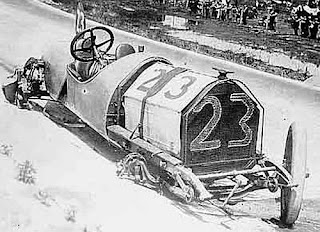 |
| 1912 McFarlan Indy Racer after the crash Photo courtesy of Indianapolis Motor Speedway |
Marquette and the McFarlan racer returned to the Speedway with riding mechanic Lay Fowler in 1912; the pair finished 19th after they crashed in turn four and sheared off both right side wheels.
 |
| The McFarlan 572 CI 6-cylinder engine |
The exclusive McFarlan automobiles, equipped with twin valve 6-cylinder 572-cubic inch 120-horsepower engines, which measured nearly six feet in length and featured three spark plugs per cylinder, were regarded as the “American Rolls Royce” by the elite citizens in major US cities. Besides Wallace Reid, other notable owners of McFarlan automobiles included noted director William Desmond Taylor, gangster Al Capone (who owned two) and boxer Jack Dempsey. The Warner Brothers film studio fleet included two McFarlan limousines.
![]() In late 1919, Wallace Reid sustained serious injuries in a train accident while filming The Valley of Giants. In the silent era, movies were filmed and distributed rapidly; in order to maintain the busy shooting schedule, the studio chiefs found doctors to prescribe morphine to their star to mask the pain of his injuries, and before long, Reid became addicted. In 1920, Reid who earned $1,750 a week appeared in three more auto-racing movies, Double Speed, What’s Your Hurry, and the sequel to The Roaring Road entitled Excuse My Dust, which also featured the film debut of his 3-year old son. These three films also featured real-life drivers Eddie Hearne, 1922 ‘500’ winner Jimmy Murphy, Joe Thomas and Eddie Miller, again filmed on portions of the Santa Monica road course. The Reid racing films proved very popular at the box office, as they attracted female fans to see the handsome Reid, and male fans to see the racing stars and exciting action scenes. In 1921, Wallace made only one racing themed film, entitled Too Much Speed, but attended the Indianapolis ‘500’, and watched the race from the pit of his friend Roscoe Sarles, known as “the clown of the races,” who finished second in a Duesenberg after leading a lap early in the race.
In late 1919, Wallace Reid sustained serious injuries in a train accident while filming The Valley of Giants. In the silent era, movies were filmed and distributed rapidly; in order to maintain the busy shooting schedule, the studio chiefs found doctors to prescribe morphine to their star to mask the pain of his injuries, and before long, Reid became addicted. In 1920, Reid who earned $1,750 a week appeared in three more auto-racing movies, Double Speed, What’s Your Hurry, and the sequel to The Roaring Road entitled Excuse My Dust, which also featured the film debut of his 3-year old son. These three films also featured real-life drivers Eddie Hearne, 1922 ‘500’ winner Jimmy Murphy, Joe Thomas and Eddie Miller, again filmed on portions of the Santa Monica road course. The Reid racing films proved very popular at the box office, as they attracted female fans to see the handsome Reid, and male fans to see the racing stars and exciting action scenes. In 1921, Wallace made only one racing themed film, entitled Too Much Speed, but attended the Indianapolis ‘500’, and watched the race from the pit of his friend Roscoe Sarles, known as “the clown of the races,” who finished second in a Duesenberg after leading a lap early in the race.
![]() In early 1922, the American Automobile Association (AAA) issued Reid competition license # 145, and the Paramount studio released what would prove to be Reid’s last auto racing film, Across the Continent. Reid also ordered a second McFarlan automobile, an enormous 1923 model 154 ‘Knickerbocker’ cabriolet at the cost of $9,000 ($125,000 in 2012), and in March, over the objections of producer Jesse Lasky, Wallace Reid filed an entry to drive the previous year’s fourth place finisher, a Duesenberg, in the 1922 Indianapolis “500-mile Classic.” However, by this time, Reid’s morphine addiction was in an advanced stage, and his wife eventually persuaded Wallace to withdraw his entry after the Speedway opened. In September 1922, at the inaugural AAA 300-mile race at the short-lived 1-1/4 mile board track in Kansas City Missouri, Reid’s friend Roscoe Sarles filling in for Cliff Durant, crashed into Peter Depaolo’s wrecked car on lap 114. Sarles’ Miller hurtled the guardrail at the top of the banking, crashed to the ground 25 feet below and Sarles burned to death trapped in the wreckage. A month later, Reid’s morphine addiction became intolerable and he entered a series of sanitariums for treatment, and finally wound up at the up-scale Banksia Place Sanitarium. Addiction treatment was in its infancy and Reid suffered horrible withdrawal symptoms before he succumbed to pneumonia in January 1923, only 31 years old, never having had the chance to drive his new deep red McFarlan cabriolet.
In early 1922, the American Automobile Association (AAA) issued Reid competition license # 145, and the Paramount studio released what would prove to be Reid’s last auto racing film, Across the Continent. Reid also ordered a second McFarlan automobile, an enormous 1923 model 154 ‘Knickerbocker’ cabriolet at the cost of $9,000 ($125,000 in 2012), and in March, over the objections of producer Jesse Lasky, Wallace Reid filed an entry to drive the previous year’s fourth place finisher, a Duesenberg, in the 1922 Indianapolis “500-mile Classic.” However, by this time, Reid’s morphine addiction was in an advanced stage, and his wife eventually persuaded Wallace to withdraw his entry after the Speedway opened. In September 1922, at the inaugural AAA 300-mile race at the short-lived 1-1/4 mile board track in Kansas City Missouri, Reid’s friend Roscoe Sarles filling in for Cliff Durant, crashed into Peter Depaolo’s wrecked car on lap 114. Sarles’ Miller hurtled the guardrail at the top of the banking, crashed to the ground 25 feet below and Sarles burned to death trapped in the wreckage. A month later, Reid’s morphine addiction became intolerable and he entered a series of sanitariums for treatment, and finally wound up at the up-scale Banksia Place Sanitarium. Addiction treatment was in its infancy and Reid suffered horrible withdrawal symptoms before he succumbed to pneumonia in January 1923, only 31 years old, never having had the chance to drive his new deep red McFarlan cabriolet.
 In late 1919, Wallace Reid sustained serious injuries in a train accident while filming The Valley of Giants. In the silent era, movies were filmed and distributed rapidly; in order to maintain the busy shooting schedule, the studio chiefs found doctors to prescribe morphine to their star to mask the pain of his injuries, and before long, Reid became addicted. In 1920, Reid who earned $1,750 a week appeared in three more auto-racing movies, Double Speed, What’s Your Hurry, and the sequel to The Roaring Road entitled Excuse My Dust, which also featured the film debut of his 3-year old son. These three films also featured real-life drivers Eddie Hearne, 1922 ‘500’ winner Jimmy Murphy, Joe Thomas and Eddie Miller, again filmed on portions of the Santa Monica road course. The Reid racing films proved very popular at the box office, as they attracted female fans to see the handsome Reid, and male fans to see the racing stars and exciting action scenes. In 1921, Wallace made only one racing themed film, entitled Too Much Speed, but attended the Indianapolis ‘500’, and watched the race from the pit of his friend Roscoe Sarles, known as “the clown of the races,” who finished second in a Duesenberg after leading a lap early in the race.
In late 1919, Wallace Reid sustained serious injuries in a train accident while filming The Valley of Giants. In the silent era, movies were filmed and distributed rapidly; in order to maintain the busy shooting schedule, the studio chiefs found doctors to prescribe morphine to their star to mask the pain of his injuries, and before long, Reid became addicted. In 1920, Reid who earned $1,750 a week appeared in three more auto-racing movies, Double Speed, What’s Your Hurry, and the sequel to The Roaring Road entitled Excuse My Dust, which also featured the film debut of his 3-year old son. These three films also featured real-life drivers Eddie Hearne, 1922 ‘500’ winner Jimmy Murphy, Joe Thomas and Eddie Miller, again filmed on portions of the Santa Monica road course. The Reid racing films proved very popular at the box office, as they attracted female fans to see the handsome Reid, and male fans to see the racing stars and exciting action scenes. In 1921, Wallace made only one racing themed film, entitled Too Much Speed, but attended the Indianapolis ‘500’, and watched the race from the pit of his friend Roscoe Sarles, known as “the clown of the races,” who finished second in a Duesenberg after leading a lap early in the race.  In early 1922, the American Automobile Association (AAA) issued Reid competition license # 145, and the Paramount studio released what would prove to be Reid’s last auto racing film, Across the Continent. Reid also ordered a second McFarlan automobile, an enormous 1923 model 154 ‘Knickerbocker’ cabriolet at the cost of $9,000 ($125,000 in 2012), and in March, over the objections of producer Jesse Lasky, Wallace Reid filed an entry to drive the previous year’s fourth place finisher, a Duesenberg, in the 1922 Indianapolis “500-mile Classic.” However, by this time, Reid’s morphine addiction was in an advanced stage, and his wife eventually persuaded Wallace to withdraw his entry after the Speedway opened. In September 1922, at the inaugural AAA 300-mile race at the short-lived 1-1/4 mile board track in Kansas City Missouri, Reid’s friend Roscoe Sarles filling in for Cliff Durant, crashed into Peter Depaolo’s wrecked car on lap 114. Sarles’ Miller hurtled the guardrail at the top of the banking, crashed to the ground 25 feet below and Sarles burned to death trapped in the wreckage. A month later, Reid’s morphine addiction became intolerable and he entered a series of sanitariums for treatment, and finally wound up at the up-scale Banksia Place Sanitarium. Addiction treatment was in its infancy and Reid suffered horrible withdrawal symptoms before he succumbed to pneumonia in January 1923, only 31 years old, never having had the chance to drive his new deep red McFarlan cabriolet.
In early 1922, the American Automobile Association (AAA) issued Reid competition license # 145, and the Paramount studio released what would prove to be Reid’s last auto racing film, Across the Continent. Reid also ordered a second McFarlan automobile, an enormous 1923 model 154 ‘Knickerbocker’ cabriolet at the cost of $9,000 ($125,000 in 2012), and in March, over the objections of producer Jesse Lasky, Wallace Reid filed an entry to drive the previous year’s fourth place finisher, a Duesenberg, in the 1922 Indianapolis “500-mile Classic.” However, by this time, Reid’s morphine addiction was in an advanced stage, and his wife eventually persuaded Wallace to withdraw his entry after the Speedway opened. In September 1922, at the inaugural AAA 300-mile race at the short-lived 1-1/4 mile board track in Kansas City Missouri, Reid’s friend Roscoe Sarles filling in for Cliff Durant, crashed into Peter Depaolo’s wrecked car on lap 114. Sarles’ Miller hurtled the guardrail at the top of the banking, crashed to the ground 25 feet below and Sarles burned to death trapped in the wreckage. A month later, Reid’s morphine addiction became intolerable and he entered a series of sanitariums for treatment, and finally wound up at the up-scale Banksia Place Sanitarium. Addiction treatment was in its infancy and Reid suffered horrible withdrawal symptoms before he succumbed to pneumonia in January 1923, only 31 years old, never having had the chance to drive his new deep red McFarlan cabriolet. His widow sold the new McFarlan to ‘Fatty’ Arbuckle following Reid’s death; the massive Reid/Arbuckle car is currently a part of the fantastic Nethercutt Collection in Sylmar California (at right).
His widow sold the new McFarlan to ‘Fatty’ Arbuckle following Reid’s death; the massive Reid/Arbuckle car is currently a part of the fantastic Nethercutt Collection in Sylmar California (at right).| The Fountainhead Antique Auto Museum McFarlan before restoration |
Reid’s 1919 McFarlan, chassis number 19133, which had several special features that included bumpers, a tonneau windshield, windshield wings, and drum headlights, passed through several owners before it was purchased by the Harrah Museum in Reno Nevada, (which owned three other McFarlans) and was displayed for years in unrestored condition. In 2007, the Fountainhead Automobile Museum in Fairbanks, Alaska purchased the machine and recently restored the car to its original condition, as owned by Wallace Reid. The Museum unveiled the Model 25 Sport Touring at the recent Pebble Beach Concours where it won two awards- First in Class A-2 (Antique) and the Ansel Adams Award for Most Desirable Touring Car of Its Era.
 |
| The Fountainhead Antique Auto Museum McFarlan at the 2012 Pebble Beach Concours d'Elegance |
In the years after his death, Reid’s widow, Dorothy Davenport, an actress before their marriage, continued to work in Hollywood as a writer, director, and producer and as an advocate of the dangers of narcotics. Reid’s son, Wallace Junior, also worked in Hollywood, and starred in his own racing film at the age of 15, The Racing Strain, in 1932, a story written by his mother which tells the story of a driver who triumphs in his comeback from alcoholism which features authentic footage from the Indianapolis Motor Speedway.
The author is indebted to Nancy DeWitt of the Fountainhead Automobile Museum for her invaluable research assistance on Wallace Reid and to Al Murray for the photo of the Reid McFarlan car on the lawn at Pebble Beach.
The author is indebted to Nancy DeWitt of the Fountainhead Automobile Museum for her invaluable research assistance on Wallace Reid and to Al Murray for the photo of the Reid McFarlan car on the lawn at Pebble Beach.










